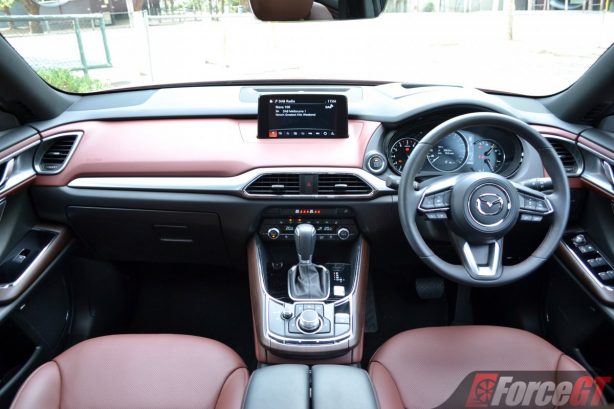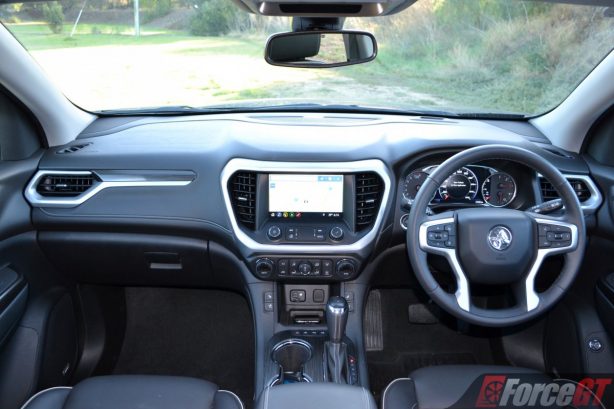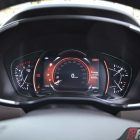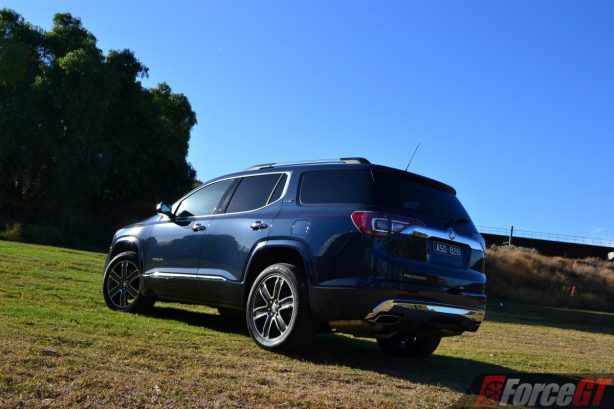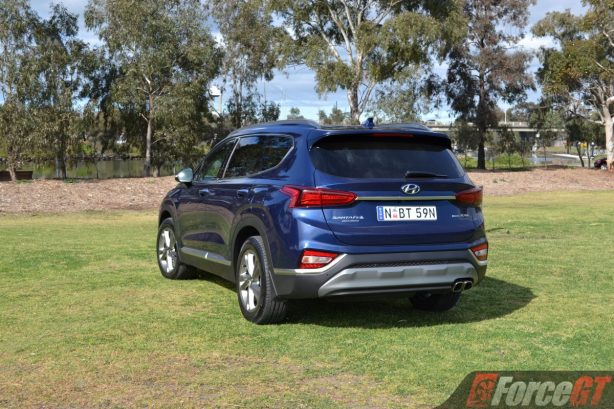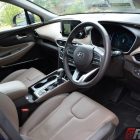The 7-seat SUV has become the modern definition of a family car, loved for its space, comfort and versatility. With the market segment saturated with no less than eight players, which of these family buses should you spend your hard earned money on?
Here, we take a look at the three latest releases into the segment: the all-conquering Mazda CX-9, the excellent Hyundai Santa Fe, and newcomer Holden Acadia.
To fully explore what these full-size SUVs have to offer, we have gathered the range-topping grade of each model and put them through their paces.
Price and Features
Priced at $60,500 plus on-road costs, the 2019 Hyundai Santa Fe Highlander is the least expensive of the pack and comes packed with all the bells and whistles that would satisfy even the most demanding of families. The long list of standard features includes all-wheel drive, an 8-inch infotainment system with satellite navigation, Apple CarPlay and Android Auto, 7-inch instrumentation cluster, wireless phone charger and head up display.
Creature comforts usually found in luxury cars such as heated steering wheel, heated and ventilated front seats, heated rear outboard seats and panoramic glass sunroof have also made it to the top-spec Santa Fe.
And of course, essential safety features are all there to keep everyone safe and they include 6 airbags, forward collision avoidance with automatic emergency braking, adaptive cruise control, blind-spot monitoring, rear cross traffic alert, lane keep assist and surround view monitor.
The Santa Fe goes a step further with a feature called Safety Exist Assist that is designed to prevent accidents by automatically and temporarily locking the doors when vehicles are approaching from behind. The doors are unlocked when it’s deemed safe so that passengers can exit the car safely. The feature, which is unique to the Hyundai, was put to the test and it worked brilliantly.
The 2019 Mazda CX-9 pushes further upmarket with the introduction the new range-topping CX-9 Azami LE. Coming in at $64,990 plus ORCs, the Mazda asks for quite a fair chunk more than the Hyundai but costs less than the Holden of equivalent spec. It does come with some really nice details which we will cover in more detail in the next few sections but you could save about $1,500 by buying the Azami grade that is basically spec’ed the same as the Azami LE, only missing on some interior wood trim and other minor aesthetic details.
Feature wise, the CX-9 is neck and neck with the Santa Fe, matching it in everything from occupant comfort and entertainment to safety and driving aids, with notable differences being the presence of rear climate temperature control and heated outboard mid-row seats in the Mazda that are missing in the Hyundai, and the inclusion of third-row air-con vents in the Korean car which are nowhere to be seen in the Japanese car.
The Mazda is the only car here with just a regular sunroof, as opposed to the panoramic sunroof in the Hyundai and dual-panel sunroof in the Holden. It’s also the odd one out without a one-touch second-row seat slide and tilt feature, requiring a two-step process to move the seats forward.
Holden’s American-sourced Acadia has the priciest sticker of the lot if we are comparing apples with apples. While the Santa Fe and CX-9 are both all-wheel drive only in range-topping form, the Acadia can be had with either AWD or 2WD in every grade. For a fair pricing comparison, we are looking at $67,490 plus ORCs for the flagship Acadia LTZ-V all-wheel drive, but the price drops to $63,490 for the 2WD version, which is what we have on test here.
As expected from a top-spec model, and just like the Santa Fe and CX-9, the Acadia LTZ-V is equipped to the brim. While its specifications largely mirror those of the Hyundai and Mazda, there are a few exceptions. The Holden is only car here without a head-up display and sunshades for the middle row, the former a major oversight for a range-topper. And like the Hyundai, it’s also lacking heated rear outboard mid-row seats.
Ventilation is available across all three rows with roof-mounted air-con vents, with the third-row also offered with a single USB charging port that you won’t find in the other two contenders.
Exterior
The Santa Fe is a good looking car from every angle, with elegant lines and classy touches accentuating its nearly perfect proportions, though some find may the oddball front lighting layout – daytime running lights at the top cluster, main and high beam at the bottom – a little hard to digest.
True to its American roots, the Acadia looks big and brash, with plenty of chrome highlights and a boxy styling overall. It’s a rugged design for sure and one that stands out, but like the Hyundai, some of those truck-like styling element can be divisive.
While there’s no mistaken both the Santa Fe and Acadia are offerings from mainstream brands, the CX-9 on the other hand looks more like a product from a premium marque. With a sculpted body serving as a backdrop for smooth lines and fine details such as that imposing yet beautifully crafted grille, there just isn’t a single bad angle about the car. In the upper spec variants such our Azami LE, the CX-9 can easily flirt with luxury cars costing twice as much.
Interior
Unlike the exterior, things are definitely a lot more conventional on the inside of the Santa Fe, with the sweeping layered dashboard giving a sense of space and the grooves on the speaker cover and upper seat cushion adding a touch of style.
Some of our testers – myself included – are not huge fan of the optional ($295) dark beige two-tone leather interior, feeling it looks too chocolatey and earthy, though there’s no denying the trimming is incredibly detailed and thorough. And the rest of the cabin echoes this high quality build and finish, with all contact points trimmed in soft touch surfaces and the interior as a whole largely devoid of harsher, scratchier plastics.
If the Mazda’s exterior has managed to impress us, then the interior has simply blown us away. The entire look and feel of the cabin speak of top-class luxury, with soft surfaces adorning the upper dashboard and door trim, lifted by premium glossy trim in the lower centre console and lavish leather upholstery. There’s also a sweeping single piece of aluminum across the dashboard, emphasizing width.
The cabin is impeccably well put together, with faultless fit and finish and a tactile feel to all switches, buttons and knobs. In fact, it would come as a surprise to many that this cabin belongs to a car costing just sixty odd grand. It’s in a different class to that of the other two cars.
The Acadia’s interior is the least impressive of the three, both in terms of presentation and fit and finish. Like the exterior, the cabin design is more utilitarian than stylish, with big squarish buttons littered around the place and a bulky steering wheel devoid of styling elements.
Build quality is also questionable in certain areas, such as the sharp edges on some of the cheap-feeling hard plastic trim pieces and worse, the rubber trim cover surrounding the wireless phone charging pad peeling off.
Things don’t get better either when you start using the interior with the tactile feel of many switches feeling cheap thanks to lots of play when activated, particularly the handbrake button and gear selector. The infotainment touch screen is also too upright, when it should be angled slightly for easier operation and better visibility.
All three SUVs offer comfortable seating for occupants in the first and second row, it’s in the third row where things vary between the models. The Santa Fe has the tightest third row space, with them only good for small children. The Acadia and CX-9 both can accommodate adults in the third row but only the latter has sufficient leg and head room to keep occupants back there happy for longer than just trips to the local shopping mall.
In terms of ease of access to the third row seats, the order changes for the Holden and Mazda, with the Hyundai again offering the tightest access with second row seats that slide forward the least, while the Holden granting the widest entry thanks to rear doors that open up to near 90 degrees and the large aperture of the door opening itself.
The Acadia takes it home for the third row with the largest window of the three, which together with the rear sunroof, let in the most amount of natural light into the third row.
The Santa Fe does, however, compensate its less practical third row with large storage compartments around the cabin, with the most voluminous centre storage (the CX-9’s is painfully tiny while the Acadia is nearly as big) and extra storage above the glove box and under the rear air vents.
The pendulum is swung once again in Holden’s direction when it comes to cargo space. With the third row up, the Acadia has a usable 292 litres of boot space available that can extend to a capacious 2,102 litres with both middle and third rows dropped. In order to get the mid-row 60/40 seats flat however, you will need to remove the centre headrest which again, is a poor design decision.
The CX-9 offers 230 litres of boot space, expanding to 1,641 litres with the mid and third row seats tumbled. The Santa Fe’s boot space is the smallest in all configurations, with the figures coming in respectively at 130 and 1625 litres.
Performance
The Santa Fe Highlander sports a 2.2-litre four-cylinder turbo diesel under the bonnet producing 147kW and 440Nm, making the Hyundai the least powerful but the one with the most torque in this company.
It’s not the most refined diesel powerplant out there, with a distinct clatter to it on idle and when accelerating at lower speeds. It does settle down considerably once on the move and in the higher gears. On the freeway, there’s nearly no signs of a diesel tickling up front, and not only that, the whole cabin is quiet too with minimal road and wind noise intrusion.
With peak torque holding from a low 1,750 to 2,750rpm, the engine gets you moving and up to speed briskly, with torrents of pull in the mid range for swift overtaking. It’s got everything needed to handle the near 2 tons of weight and more.
The CX-9’s 2.5-litre direct-injection turbo petrol engine outputs 170kW and 420Nm, eclipsing the Santa Fe in power but falling shy of it in peak torque, which also arrives 250rpm higher at 2,000rpm.
Being petrol fueled, the CX-9’s engine is inherently quieter and more refined than the Santa Fe’s oiler. But that itself is an understatement because this mill is one of the best turbo petrol engines we have come across, delivering responsive power and diesel-like grunt without the slightest hint of turbo lag.
The Mazda feels strong across the rev range, as the turbo four shows no signs of fading until around 5,000rpm where peak power is produced. It’s got everything on the Hyundai, only better.
The job of hauling the hulking Acadia falls to the atmospheric 3.6-litre petrol V6 with cylinder deactivation which offers up 231kW at 6,600rpm and 367Nm of torque at 5,000rpm. As the most powerful but the least grunty among the group, the V6 serves up plenty of poke that comes on linearly as it revs out. It’s also the smoothest and most refined engine here, not to mention one that also makes the best noise up top.
The power comes on early enough and if you wind it out you can really get up and going at pace. Beware though as the throttle is almost too eager on dip in and there’s no Eco mode to dull it down leading to unwanted front wheel spin on our tested 2WD version. This means a delicate touch is required on the throttle.
Like the engines, the transmissions can’t be more different between the SUVs. While they are all torque converter automatics, the Santa Fe sports eight ratios, the CX-9 has six, and the Acadia packs nine. It must be said that none of these cars have an inferior gearbox, as they are all very smooth and match well to their respective engines.
That said, the Mazda’s six-speeder does deliver the quickest and crispest shifts, which endow the SUV with the sportiest feel among the three. Meanwhile, the Acadia’s nine-speed ‘box feels the most relaxed and discrete, with the best refinement in this company, though the manual gear shifters on top of the gear lever itself is a poor design as the buttons are tiny and counter-intuitive.
When it comes to fuel economy, it’s not hard to guess the winner and loser. Being diesel-powered, the Santa Fe is inherently the most efficient, returning an average real-world fuel economy figure of 8.8L/100km. The CX-9 slots in the middle with an average of 10.3L/100km, with the Acadia surprisingly not far behind at 10.5L/100km.
On paper, the Santa Fe, CX-9 and Acadia are respectively rated at 7.5L/100km, 8.8L/100km, and 8.9L/100km on the combined average.
Ride and Handling
In terms of ride comfort, all three SUVs perform remarkably well, soaking up bumps and ruts with aplomb to deliver the kind of plush ride expected of a family SUV. However, the Acadia, having been intensively tuned for Aussie roads, does deliver a slight upper edge in overall ride quality than the other two on Australia’s varying road surfaces. As mentioned earlier, these SUVs are also impressively quiet on the freeway, with wind and road noise very well insulated.
There’s no denying the sheer size of these vehicles on the road as they weigh in near two tonnes. However, it’s not as noticeable as you’d expect as they all have crisp turn-in and good body control.
That said, the Mazda does offer the most car-like drive with the most feel and cohesiveness through the steering, along with the tightest body control.
Verdict
When it comes to big 7-seat family SUVs, the acceptance criteria is simple. There needs to a spacious interior loaded with creature comfort and the latest tech, matched with decent power and neat handling. On that brief, our contenders have all managed to deliver quite comfortably. But we are here to pick a winner and so the finer details come to play.
In terms of the third row seats, the Santa Fe has the tightest accommodation and access, while CX-9 has the most space and the Acadia has the widest access.
The CX-9 has the best interior of this lot, with the Acadia being the least impressive. The Mazda also wins on having the most premium-feeling and intuitive infotainment system, head-up display (HUD) and digital instrumentation, while the Acadia loses points for not even featuring a HUD.
With the best ride and handling balance in this company, the Mazda wraps it up as our favourite in this comparison, with the Hyundai coming in a close second for its excellent price versus value proposition.
This leaves the Acadia in the last spot. Despite its strong engine and comfortable ride, there’s still lots of room for improvement in interior presentation and overall quality, and for its high asking price there’s no excuse for leaving the odd features out when then are available in both the other two SUVs.
 ForceGT.com Car News, Car Reviews, Video Reviews, Tuning and much more.
ForceGT.com Car News, Car Reviews, Video Reviews, Tuning and much more. 




